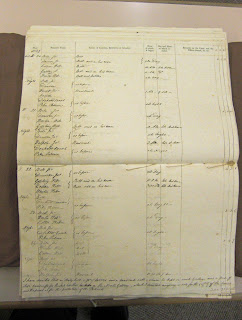 |
| Lincoln Lunatic Asylum (HOSP/LAWN/3/8/1) |
This was a just a one day “sampling” visit so that I could get some idea of the scope, completeness and age of the surviving records. By closing time I had been unable to examine the full range of records I had wished to check, for the simple reason that I had become engrossed with the content of those which I had been able to view. Being familiar with the WRPLA records held by WYAS I had some idea of the likely content to be found in Lincoln but I was still pleasantly surprised with what I discovered.
 |
| Minute Book, 1807 (HOSP/LAWN/1/1/1) |
 |
| Page from Director's Journal, (HOSP/LAWN//1/2/1) |
Although some date ranges are missing and the poor condition of some journals means that they are “Not For Production” these journals should allow the patient researcher, pun intended, to build up a relatively complete picture of observations and treatment for each of the earliest patients. No such journals survive in the WRPLA collection but reference has been found to the fact that they had existed and had been used to retrospectively create the very earliest case books.
 |
| Admission Papers for John ROBINSON, 1820. (HOSP/LAWN/2/11/0/1) |
Bundles of still folded Admission Papers (HOSP/LAWN/2/11/0) survive being the legal paperwork required to admit a patient to the Asylum. There are some papers missing, including almost inevitably, those for the very first admission. The numbering of these admissions suggests that in its first 50 years Lincoln admitted around 2,000 patients in complete contrast to WRPLA which admitted around 11,500 patients over the same period. What I found particularly interesting was the different paperwork accompanying patients being admitted privately as all the earliest admissions to WRPLA were at least part funded from local poor rates.
Statutory Registers of Admissions (HOSP/LAWN/2/6) and Removals, Discharges and Deaths (HOSP/LAWN/2/22) survive for the period after 1845 when the Commissioners in Lunacy were formed. Reporting to the Home Secretary, this body took responsibility for the management of the country’s strategy for the treatment of the insane in county asylums, private asylums, workhouses and prisons.
 |
| Register of Patients' Work, 1836. (HOSP/LAWN/2/18/1) |
 |
| Page from Register of Restraints, 1829 (HOSP/LAWN/2/19/1) |
The Register of Restraints (HOSP/LAWN/2/19) was of particular interest as in the 1840s Lincoln Asylum was hailed as being the first example of a system of patient management which did not need to use mechanical restraint. The earliest register (HOSP/LAWN/2/19/1) dated 1829 – 1832 reads like a shopping list for a torture chamber, for example, body belt and hobbles, so clearly things must have changed.
I will be delving further into the records and writing more about what I found in the Lincoln Lunatic Asylum archives over the course of the next few weeks.
